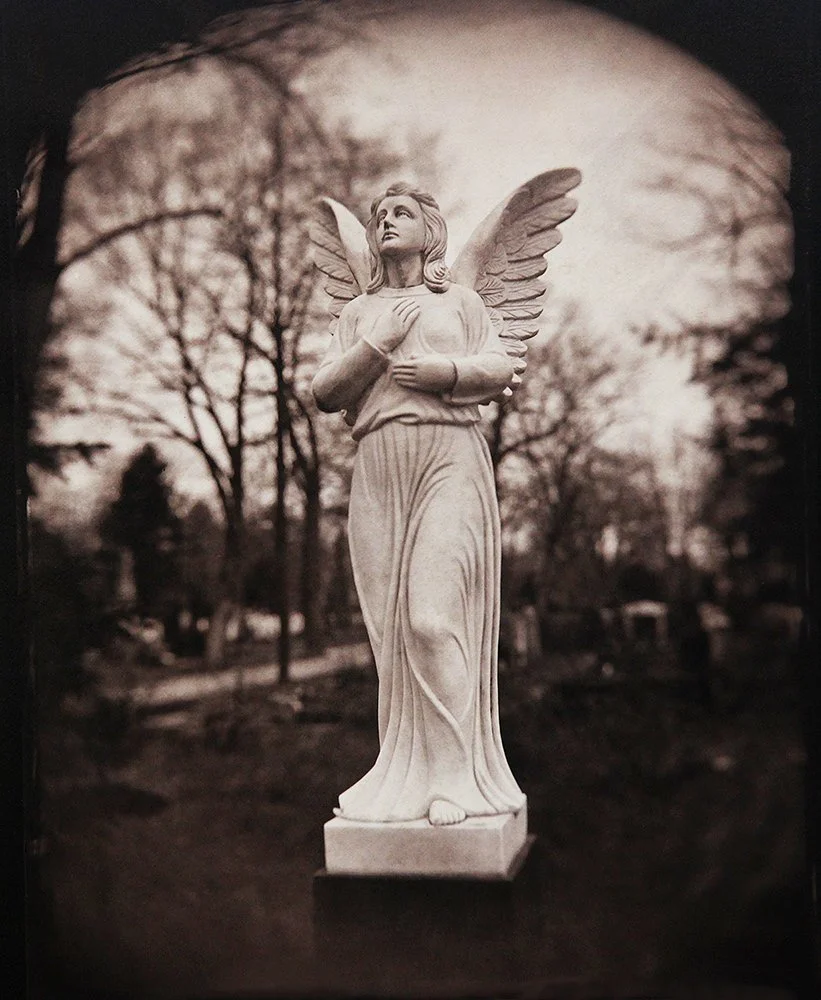I printed this 4x5 salt print today from a negative I made back in 2009, when I was living in Germany. Pulling an old plate like this into the present is always a strange experience. It’s like opening a time capsule you didn’t realize you buried. The negative was unvarnished—intentionally, because I wanted to see how far the elements had carried it over sixteen years. The result is this distressed, fractured surface that feels less like damage and more like memory asserting itself.
The subject is a simple setup: a cigar-box guitar propped on an old chair, a yarmulke (I got in Budapest) hanging beside it. At the time, I was thinking about the way ordinary objects can hold the weight of identity and belonging. Today, the print reads differently. The salt process softened everything, pulled it into an older register. The marks, flaws, and chemical bruises add a gravity the original plate didn’t have. It’s as if the print has aged along with me, and it’s finally showing its own scars.
Salt prints have a way of whispering rather than shouting. They blur the line (no pun) between what’s depicted and what’s remembered. This one carries the ghosts of two moments: who I was in 2009, exploring Europe with a camera and too many questions, and who I am now, printing in the desert, working at the intersection of creativity and mortality. These processes keep teaching me that nothing stays untouched—not glass plates, not bodies, not beliefs. Everything changes.
What I love most about this print is that it feels like a conversation between past and present versions of myself. A reminder that every piece of work we make continues living long after we think we’ve finished with it.
Impermanence and Insignificance: A Brief Note from the Void
I’ve been sitting with Escape from Evil again, and every time I revisit Becker’s later work, I feel the same jolt. He names the thing we spend our lives circling. Not death, exactly, but the quieter dread underneath it, the fear of slipping through this world without leaving so much as a fingerprint. Impermanence on one side. Insignificance on the other. It’s a tight little vise. And it’s psychologically terrifying.
Becker saw our terror clearly: we are symbolic creatures who can imagine infinity, yet we’re trapped in these fragile, temporary bodies that can vanish in a moment. The universe isn’t just big. It’s indifferent. And in that indifference, we feel an echo of our own smallness.
“The real fear isn’t the moment of dying. It’s the reckoning that follows: what does our ending reveal about how we lived?”
Most of us respond by building what Becker called “immortality projects”—the long list of things we hope will grant us some kind of permanence (like what I’m doing right now). Careers. Families. Beliefs. A reputation. A legacy. Art. Even the small rituals of daily life can start to feel like talismans against oblivion. Becker never mocked these efforts. He understood their necessity. Without them, we’d drown in the sheer scale of our vulnerability.
For me, that tension shows up every time I work. Photography, especially the old processes I use, makes this dance impossible to ignore. A wet collodion plate holds everything and nothing at once. Light settles on silver and forms an image that can last centuries, yet the plate itself is so delicate you can wipe it clean with a rag or crack it between two fingers. It’s the same paradox Becker lived in: durability wrapped in impermanence.
And honestly, that’s why I keep returning to these ancient materials. They tell the truth gently. They remind me that nothing I make will rescue me from the limits of being human. But the making still matters. Maybe that’s the part Becker understood so well: our projects don’t need to defeat insignificance; they only need to give us a way to live with it.
Impermanence isn’t the enemy. Insignificance isn’t a verdict. They’re conditions. The water we swim in, if you will.
What we create—our art, our relationships, our gestures of care—won’t make us immortal. But they mark our brief time here with intention rather than avoidance. They let us stand, for a moment, in the truth of our smallness and still say: I was here. I noticed. I tried.
That might be enough.

















